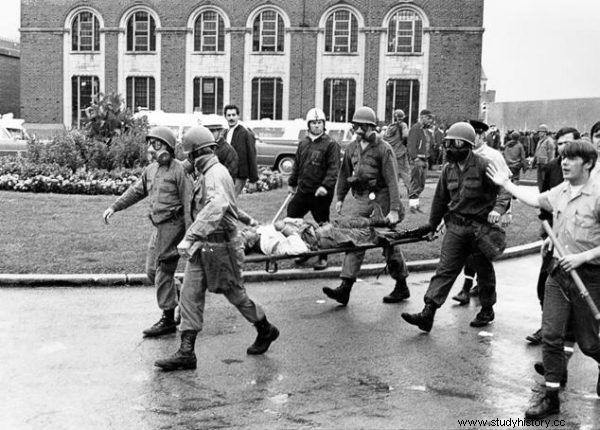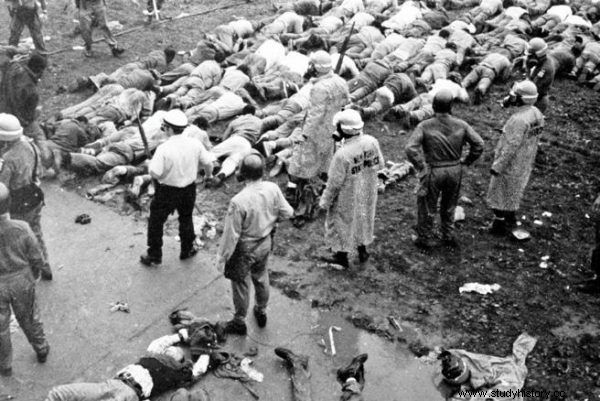Forty-three killed, countless wounded and tortured - this is the record of the events that rocked a prison in Attice, New York, in 1971. On September 9, nearly 1,300 inmates rebelled against the dramatic conditions in the facility. They paid dearly for it…
When on the fifth day of the riots over the Attica prison a massive helicopter flew in, the detainees did not hide their joy. They hoped Governor Nelson Rockefeller had come to support them in the negotiations and help them find a way out of the stalemate. They quickly realized their mistake. In retaliation for the rebellion, the authorities staged a bloody slaughterhouse for them ...
Prison powder keg
Located near the inconspicuous town of Attica, New York, the maximum security prison was at first sight terrifying. Surrounded by a massive, gray wall nine meters high, even in the early 1970s it was archaic - it has survived almost unchanged since its opening during the Great Depression. Heather Ann Thompson in the Pulitzer Prize-winning book Bloody Rebellion. The story of the uprising in the American Attica prison reports:
The overwhelming portion of Attica's 2,243 prisoners were young, poorly educated urbanites, as well as African Americans and Puerto Ricans. For more than two-thirds of inmates, Attica was already at least a second prison.
This did not mean, however, that all Attica's prisoners were unrepentant criminals. Many were brought here for breaking parole rules, and some of them were far too young to face the hardships of living in a maximum security prison.
The conditions in which they served their sentences were dramatic. The state authorities only provided them with two gray work shirts, a thin coat, three pairs of trousers, the same number of underwear, six pairs of socks and a comb and one pair of shoes. Once a month, they were given an allowance of a bar of soap and a roll of paper. The prison had a budget of 63 cents a day for food - many inmates were therefore on an empty stomach.
In order to improve their standard of living a little, they had to work. However, regardless of the type of activity (whether it was clearing snow, or in the prison laundry or kitchen), most earned a maximum of 6 cents a day, which made their work even slave (for comparison - a bus ticket to the nearest city where the train station was located). it cost over $ 30 at the time.
The prisoners spent their time mostly in claustrophobic cells (and breaking the strict rules they were kept in "quarantine" even 24 hours a day), where after 8 p.m. there was a total ban on talking. They were allowed to go to the yard yard for only half an hour a day. When they fell ill, prison doctors usually sent them (untested) with aspirin. The complete lack of interest in the patients' condition finally caught the attention of the civilian employees of the facility, but they failed to do anything about it.
If you add to this the widespread discrimination in the facility, the growing overpopulation, and at the same time the developing socio-political awareness of prisoners, who throughout the state began to speak out loudly for their rights, in fact, it is hardly surprising how the events in Attica turned out. Rebellion - in one form or another - was inevitable.
Fight for dignity
The tension in the facility, which had been growing since 1970, reached a critical point in the summer of the following year. In late June, a group of inmates referring to themselves as the Attica Liberation Faction wrote a letter to the then prison commissioner, Russell Oswald.
Inmates accused the administration and prison staff of "not considering them human beings". They also demanded the implementation of 28 reforms, including improving living conditions, changing medical procedures, and introducing freedom of religion. Reaction of the authorities? Anyone caught with the manifesto waited 60 days in solitary confinement. The existing - and so strict - rules have also been tightened.

The guards are removing the prisoner's body
Although Oswald tried to calm the mood by promising to make some changes, the promises ended. Heather Ann Thompson in her book reports:
In mid-August 1971, with daytime temperatures reaching 32 degrees and dropping below 20 degrees at night, a sense of pointlessness and frustration pervaded the stifling, still air of five hot blocks of Attica Prison.
The optimism these people had indulged in just a month earlier, when it was still believed that a Commissioner for the Department of Corrections could do something for them, now seemed naive. The stench of nearly 2,300 sweaty men hovering over the cell blocks like a poisonous cloud could have convinced even the most patient prisoners that Oswald had fooled them.
Finally, on September 9, a rebellion broke out in the prison - as it would soon turn out:the bloodiest rebellion in the history of the American penitentiary system. An attack on one of the guards sparked a revolt, soon joined by 1,281 prisoners. They managed to take control of the facility. They also took 42 hostages from among the crew. They demanded that their demands be met.
An eye for an eye?
Nervous negotiations continued over the next four days. Both sides counted on the success of the talks, but failed to reach a consensus - even with the arrival of a large group of external observers. Although the rebellion attracted the attention of the media - and many influential figures in America at that time, Governor Nelson Rockefeller did not bother Attica, whose support the prisoners counted on.
Meanwhile, the authorities were already preparing a plan to recover the prison. The decision to pacify the rebellion (which had so far been rather peaceful) was made on September 13. Measures decidedly disproportionate to the situation were used. The guards and policemen who surrounded the facility in the morning were dressed in "gray camouflage outfits and equipped with helmets, shotgun clubs and other weapons."

New York City guards and policemen stand over a crowd of inmates forced to crawl in the mud of Courtyard D. Courtesy of the Associated Press)
Two helicopters were also sent to Courtyard D, where the rebels had gathered. At first the prisoners thought it was Governor Rockefeller who finally decided to meet them, but soon found them wrong. Suddenly, one of the machines began to spray a thick, light mist. In the book Bloody Rebellion Heather Ann Tohompson describes:
Within moments, the air above the prison was thick with a mixture of CS and CN gases - heavy dust that instantly clung to everyone in its range, made the air vomit and knocked them to the ground.
(...) a pale fear fell on the prisoners. Before they could escape or hide anywhere, a cloud of white smoke enveloped them, causing them to vomit instantly. "I wiped out everything I ate (...) then (...) I started to spit blood," Roche remembered. Another prisoner began to vomit violently when a gas canister exploded right next to him, and the white powder made "his eyelids swollen and impossible to lift, and his mouth, nose, and lungs were on fire."
The terrifying effectiveness of the attack is best evidenced by the fact that even the observers of the action felt the impact of the toxic substance on their own skin , located in a nearby administrative building (with tightly closed windows!).
At the same time, uniforms entered the facility. Despite the limited visibility, they opened fire - regardless of the fact that they were injuring not only the inmates, but also the hostages they had captured. Those who survived later recalled that "the air was thick with bullets," and the prisoners were "shot, despite that they raised their hands up and begged for mercy. ” . One inmate, James Lee Asbury, reported that, ten minutes after the storm had started, wherever he looked, he saw blood, mud and water.
The seizure of Attica from the hands of the rebel prisoners cost the lives of 43 people - including 29 inmates. A total of 128 prisoners were injured. The highest price for the use of force by the authorities was also paid by hostages - guards and civilians (including the factory foreman, as well as the chief accountant and his nephew). The dimensions of the catastrophe into which the suppression of rebellion turned was perhaps best summed up by Commissioner Oswald, saying:"I guess to some extent I understand what Truman must have felt when he decided to use the atomic bomb."
The tragedy of the prison rebellion victims also had a positive effect - it initiated changes in the New York state penitentiary system (the same that the prisoners had previously unsuccessfully asked for). For this reason, the Attica uprising remains the most significant - and bloody - rebellion in the history of American prison to this day.
Source:
The text is based on the Pulitzer Prize-winning book by Heather Ann Thompson Bloody Rebellion. The story of the uprising in the American Attica prison , which was released by the Editio publishing house.
